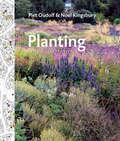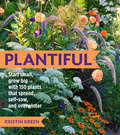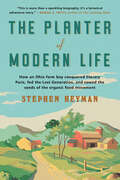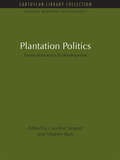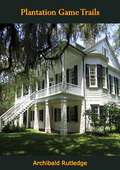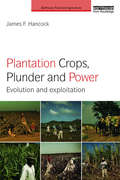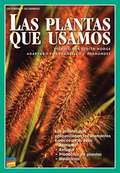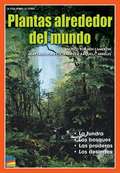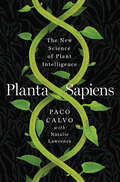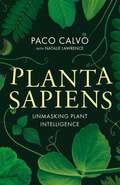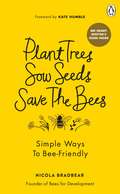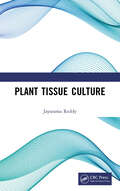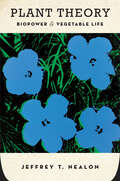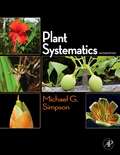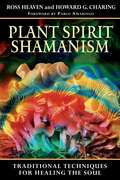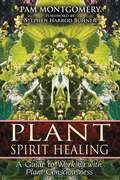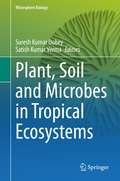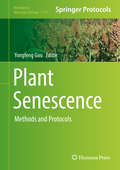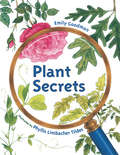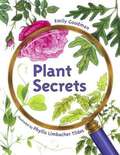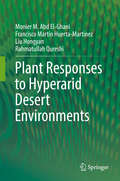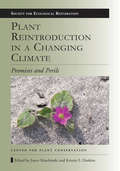- Table View
- List View
Planting: A New Perspective
by Noel Kingsbury Piet OudolfPlanting: A New Perspective is an essential resource for designers and gardeners looking to create plant-rich, beautiful gardens that support biodiversity and nourish the human spirit. An intimate knowledge of plants is essential to the success of modern landscape design, and Planting makes Oudolf’s considerable understanding of plant ecology and performance accessible, explaining how plants behave in different situations, what goes on underground, and which species make good neighbors. Extensive plant charts and planting plans will help you choose plants for their structure, color, and texture as well as the way they perform in the landscape. A detailed directory with details like each plant’s life expectancy, the persistence of its seedheads, its tendency to spread, and propensity to self-seed, this book is a beautiful and invaluable resource.
Plantiful: Start Small, Grow Big with 150 Plants That Spread, Self-Sow, and Overwinter
by Kristin Green“Thrifty gardeners take note: the bucks saved on plant purchases will pay back the purchase price of Plantiful with dividends.” —Tovah Martin, author of The Unexpected Houseplant Whoever coined the phrase “money doesn’t grow on trees” must not have been a resourceful gardener. Plantiful shows you how to have an easy, gorgeous garden packed with plants by simply making the right choices. Kristen Green highlights plants that help a garden quickly grow by self-sowing and spreading and teaches you how to expand the garden and extend the life of a plant by overwintering. The book features plant profiles for 50 self-sowers (including columbine, milkweed, and foxglove), 50 spreaders (such as clematis, snow poppy, and spearmint), and 50 plants that overwinter (including lemon verbena, begonia, and Chinese hibiscus). Additional gardening tips, design ideas, and inspirational photos will motivate and inspire gardeners of all levels.
The Planter of Modern Life: Louis Bromfield And The Seeds Of A Food Revolution
by Stephen HeymanHow a leading writer of the Lost Generation became America’s most famous farmer and inspired the organic food movement. Louis Bromfield was a World War I ambulance driver, a Paris expat, and a Pulitzer Prize–winning novelist as famous in the 1920s as Hemingway or Fitzgerald. But he cashed in his literary success to finance a wild agrarian dream in his native Ohio. The ideas he planted at his utopian experimental farm, Malabar, would inspire America’s first generation of organic farmers and popularize the tenets of environmentalism years before Rachel Carson’s Silent Spring. A lanky Midwestern farm boy dressed up like a Left Bank bohemian, Bromfield stood out in literary Paris for his lavish hospitality and his green thumb. He built a magnificent garden outside the city where he entertained aristocrats, movie stars, flower breeders, and writers of all stripes. Gertrude Stein enjoyed his food, Edith Wharton admired his roses, Ernest Hemingway boiled with jealousy over his critical acclaim. Millions savored his novels, which were turned into Broadway plays and Hollywood blockbusters, yet Bromfield’s greatest passion was the soil. In 1938, Bromfield returned to Ohio to transform 600 badly eroded acres into a thriving cooperative farm, which became a mecca for agricultural pioneers and a country retreat for celebrities like Humphrey Bogart and Lauren Bacall (who were married there in 1945). This sweeping biography unearths a lost icon of American culture, a fascinating, hilarious and unclassifiable character who—between writing and plowing—also dabbled in global politics and high society. Through it all, he fought for an agriculture that would enrich the soil and protect the planet. While Bromfield’s name has faded into obscurity, his mission seems more critical today than ever before.
Plantation Politics: Forest plantations in development (Natural Resource Management Set)
by Stephen Bass Caroline SargentPlantations are playing an increasingly important part in the development and the economies of the South. Plantation Politics is the first book to examine their rationale and purpose, exposing the misconceptions and myths that have surrounded their role, and describing the contribution they can make to sustainable development. At their best, industrial plantations can become a major asset to local development by providing raw materials, infrastructure, employment, income and environmental and recreational services. At their worst, plantations, usually imposed from a 'top-down' perspective and ignoring local needs, values and rights, have monopolized land in times of food shortage, degraded wild animal and plant populations, and destroyed habitats and landscapes. The contributors analyse the conditions appropriate for both simple and complex plantations, and the contributions each can make. Complex plantations, whether established from scratch or within natural forest, are more suitable in most cases, where they are subject to numerous different claims and needs. However, their ownership, management and silviculture present new challenges � challenges which, without the carefully researched guidelines offered here, current policy and research may well be ill-equipped to take up. Caroline Sargent is the Director and Stephen Bass is the Associate Director of the Forestry Programme at the International Institute for Environment and Development. Originally published in 1992
Plantation Game Trails
by Archibald Rutledge“TO have been able, during a matter of nearly thirty years, to follow the game trails of the great plantation region of the delta of the Santee—this has been my privilege. I have seen my homeland undergo great transformations during those years: the plantations have for the most part become waste tracts; many of the old families have died out; Nature has recaptured in her inimitable way what had been, for a few years, wrested from her. The game has held its own on these desolate plantations; and that is saying much in the modern day.“In these chapters I have tried to give a faithful account of the observations I have made as a hunter and as a lover of Nature. I have tried to present the wildwoods of the South as I have known them since boyhood. And I have attempted to preserve the memory of certain characters which have appeared to me worthy of a place in the picturesque gallery of American woodsmen.” (Preface)Richly illustrated throughout.
Plantation Crops, Plunder and Power: Evolution and exploitation (Earthscan Food and Agriculture)
by James F. HancockOver the last five centuries, plantation crops have represented the best and worst of industrialized agriculture – "best" through their agronomic productivity and global commercial success, and "worst" as examples of exploitative colonialism, conflict and ill-treatment of workers. This book traces the social, political and evolutionary history of seven major plantation crops – sugarcane, banana, cotton, tea, tobacco, coffee and rubber. It describes how all of these were domesticated in antiquity and grown by small landowners for thousands of years before European traders and colonists sought to make a profit out of them. The author relates how their development and spread were closely associated with government expansionist policies. They stimulated the exploration of far off lands, were the focus of major conflicts and led to the enslavement of both native and displaced peoples. From the southern United States, Latin America and the Caribbean, to Asia and Africa, plantation crops turned social structures upside down leading to revolution and government change. The economies of whole countries became tied to the profits of these plantations, leading to internal power struggles to control the burgeoning wealth. Open warfare routinely broke out between the more powerful countries and factions for trade dominance. This book shows that from the early 1500s to today, at least one of the plantation crops was always at the center of world politics, and that this still continues today, for example with the development of oil palm plantations in Southeast Asia. Written in an accessible style, it is fascinating supplementary reading for students of agricultural, environmental and colonial history.
Las plantas que usamos (Navigadores Series)
by Judith Hodge Francisco J. HernándezNIMAC-sourced textbook
Las plantas que usamos (¡Arriba la Lectura!, Level K #89)
by Lisa ShulmanNIMAC-sourced textbook. Las plantas se usan para hacer libros, ropa y muchas otras cosas. Descubre qué partes de las plantas se usan para hacer las cosas que necesitamos.
Las plantas necesitan agua (¡Arriba la Lectura!, Level K #43)
by Heather HammondsTanto los humanos como los animales dependen de las plantas para alimentarse. Por eso, es importante que las plantas reciban suficiente agua. ¿Cómo obtienen las plantas el agua que necesitan para sobrevivir? NIMAC-sourced textbook
Planta Sapiens: The New Science of Plant Intelligence
by Paco Calvo“Weaves science and history into an absorbing exploration of the many ways that plants rise to the challenge of living.” —Merlin Sheldrake, author of Entangled Life An astonishing window into the inner world of plants, and the cutting-edge science in plant intelligence. Decades of research document plants’ impressive abilities: they communicate with each other, manipulate other species, and move in sophisticated ways. Lesser known, however, is that although plants may not have brains, their internal workings reveal a system not unlike the neuronal networks running through our own bodies. They can learn and remember, possessing an intelligence that allows them to behave in flexible, forward-looking, and goal-directed ways. In Planta Sapiens, Paco Calvo, a leading figure in the philosophy of plant signaling and behavior, offers an entirely new perspective on plants’ worlds, showing for the first time how we can use tools developed to study animal cognition in a quest to understand plant intelligence. Plants learn from experience: wild strawberries can be taught to link light intensity with nutrient levels in the soil, and flowers can time pollen production to pollinator visits. Plants have social intelligence, releasing chemicals from their roots and leaves to speak to and identify one another. They make decisions about where to invest their growth, judging risk based on the resources available. Their individual preferences vary, too—plants have personalities. Calvo also illuminates how plants inspire technological advancements, from robotics to AI. Most importantly, he demonstrates that plants are not objects: they have their own agency. If we recognize plants as actors alongside us in the climate crisis—rather than seeing them simply as resources for carbon capture and food production—plants may just be able to help us tackle our most urgent problems.
Planta Sapiens: Unmasking Plant Intelligence
by Paco Calvo Natalie LawrenceWhat is it like to be a plant?It's not a question we might think to contemplate, even though many of us live surrounded by plants. Science has long explored the wonderful ways in which plants communicate, behave and shape their environments: from chemical warfare to turning their predators to cannibalism. But they're usually just the backdrop to our frenetic animal lives.While plants may not have brains or move around as we do, cutting-edge science is revealing that they have astonishing inner worlds of an alternate kind to ours. They can plan ahead, learn, recognise their relatives, assess risks and make decisions. They can even be put to sleep. Innovative new tools might allow us to actually see them do these things - from electrophysiological recordings to MRI and PET scans. If you can look in the right way, a world full of drama unfurls.In PLANTA SAPIENS, Professor Paco Calvo offers a bold new perspective on plant biology and cognitive science. Using the latest scientific findings, Calvo challenges us to make an imaginative leap into a world that is so close and yet so alien - one that will expand our understanding of our own minds.From their rich subjective experiences to how they are inspiring novel ways of approaching the ecological crisis, PLANTA SAPIENS is a dazzling exploration of the lives of plants and a call to approach how we think about the natural world in a new, maverick way.
Plant Trees, Sow Seeds, Save The Bees: Simple ways to bee-friendly
by Nicola BradbearDiscover the wonder of bees (and other stripey insects) and how to help them survive. In this little book of bees, wasps, hoverflies and more, discover the easy ways to make your gardens, window boxes and pots insect havens. Rewild your garden with plants for bees and honeybees - simple acts of kindness to save the planet. Expert Nicola Bradbear, from Bees for Development charity, shows you how and why it's so important.There are lots of fun things you can do to make a big difference.With every book sold, proceeds will be donated to Bees for Development (www.beesfordevelopment.org)
Plant Tissue Culture
by Jayarama ReddyThis book is a comprehensive text on plant tissue culture, with its past, present, and future prospects and techniques discussed in detail. In the first three chapters, the history, terminologies, and applications are given in detail. The fourth chapter is dedicated to the instrumentation of plant tissue culture. The basic techniques used in PTC are described in the sixth chapter. The details of the constituents and types of different nutrient media are discussed in the eighth chapter. In chapter number 9, methods of haploid production have been described. Bioreactors are the instruments that are used for the large-scale production of plantlets and plant products. This book is useful for all the students, researchers, teachers, and industrialists interested in plant tissue culture. Print edition not for sale in india. This book is a comprehensive text on plant tissue culture, with its past, present, and future prospects and techniques discussed in detail.
Plant Theory
by Jeffrey NealonIn our age of ecological disaster, this book joins the growing philosophical literature on vegetable life to ask how our present debates about biopower and animal studies change if we take plants as a linchpin for thinking about biopolitics. Logically enough, the book uses animal studies as a way into the subject, but it does so in unexpected ways. Upending critical approaches of biopolitical regimes, it argues that it is plants rather than animals that are the forgotten and abjected forms of life under humanist biopower. Indeed, biopolitical theory has consistently sidestepped the issue of vegetable life, and more recently, has been outright hostile to it. Provocatively, Jeffrey T. Nealon wonders whether animal studies, which has taken the "inventor" of biopower himself to task for speciesism, has not misread Foucault, thereby managing to extend humanist biopower rather than to curb its reach. Nealon is interested in how and why this is the case. Plant Theory turns to several other thinkers of the high theory generation in an effort to imagine new futures for the ongoing biopolitical debate.
Plant Systematics
by Michael G. SimpsonPlant Systematics has made a substantial contribution to plant systematics courses at the upper-undergraduate and first year graduate level. This second edition continues to provide the basis for teaching an introduction to the morphology, evolution, and classification of land plants. A foundation of the approach, methods, research goals, evidence, and terminology of plant systematics are presented along with the most recent knowledge of evolutionary relationships of plants and practical information vital to the field. In this second edition, the author includes greatly expanded treatments of families of lycophytes, ferns, gymnosperms, and flowering plants (all with full-color plates), a new chapter on species concepts and the role of systematics in conservation biology, and a new appendix summarizing basic statistical and morphometric techniques used in plant systematics studies. An explanation of maximum likelihood and Bayesian inference algorithms is included in methods of phylogenetic inference, and chapters on morphology and plant nomenclature have been augmented with new material.
Plant Spirit Shamanism: Traditional Techniques for Healing the Soul
by Howard G. Charing Pablo Amaringo Ross HeavenAn in-depth look at the role of plant spirits in shamanic rituals from around the world • Shows how shamans heal using their knowledge of plant spirits as well as the plant’s “medical properties” • Explores the core methods of plant shamanism--soul retrieval, spirit extraction, and sin eating--and includes techniques for connecting with plant spirits • Includes extensive field interviews with master shamans of all traditions In Plant Spirit Shamanism, Ross Heaven and Howard G. Charing explore the use of one of the major allies of shamans for healing, seeing, dreaming, and empowerment--plant spirits. After observing great similarities in the use of plants among shamans throughout the world, they discovered the reason behind these similarities: Rather than dealing with the “medical properties” of the plants or specific healing techniques, shamans commune with the spirits of the plants themselves. From their years of in-depth shamanic work in the Amazon, Haiti, and Europe, including extensive field interviews with master shamans, Heaven and Charing present the core methods of plant shamanism used in healing rituals the world over: soul retrieval, spirit extraction, sin eating, and the Amazonian tradition of pusanga (love medicine). They explain the techniques shamans use to establish connections to plant spirits and provide practical exercises as well as a directory of traditional Amazonian and Caribbean healing plants and their common North American equivalents so readers can ex-plore the world of plant spirits and make allies of their own.
Plant Spirit Healing: A Guide to Working with Plant Consciousness
by Pam Montgomery Stephen Harrod BuhnerA hands-on approach to working with the healing powers of plant spirits • Explores the scientific basis underlying the practices of indigenous healers and shamans • Illuminates the matrix where plant intelligence and human intelligence join • Reveals that partnering with plants is an evolutionary imperative Indigenous healers and shamans have known since antiquity that plants possess a spirit essence that can communicate through light, sound, and vibration. Now scientific studies are verifying this understanding. Plant Spirit Healing reveals the power of plant spirits to join with human intelligence to bring about profound healing. These spirits take us beyond mere symptomatic treatment to aligning us with the vast web of nature. Plants are more than their chemical constituents. They are intelligent beings that have the capacity to raise consciousness to a level where true healing can take place.In this book, herbalist Pam Montgomery offers an understanding of the origins of disease and the therapeutic use of plant spirits to bring balance and healing. She offers a process engaging heart, soul, and spirit that she calls the triple spiral path. In our modern existence, we are increasingly challenged with broken hearts, souls in exile, and malnourished spirits. By working through the heart, we connect with the soul and gain access to spirit. She explains that the evolution of plants has always preceded their animal counterparts and that plant spirits offer a guide to our spiritual evolution--a stage of growth imperative not only for the healing of humans but also the healing of the earth.
Plant, Soil and Microbes in Tropical Ecosystems (Rhizosphere Biology)
by Satish Kumar Verma Suresh Kumar DubeyThis book describes the multitude of interactions between plant, soil, and micro-organisms. It emphasizes on how growth and development in plants, starting from seed germination, is heavily influenced by the soil type. It describes the interactions established by plants with soil and inhabitant microbial community. The chapters describe how plants selectively promote certain microorganisms in the rhizospheric ecozone to derive multifarious benefits such as nutrient acquisition and protection from diseases. The diversity of these rhizospheric microbes and their interactions with plants largely depend on plant genotype, soils attributes, and several abiotic and biotic factors. Most of the studies concerned with plant–microbe interaction are focused on temperate regions, even though the tropical ecosystems are more diverse and need more attention. Therefore, it is crucial to understand how soil type and climatic conditions influence the plant–soil–microbes interaction in the tropics. Considering the significance of the subject, the present volume is designed to cover the most relevant aspects of rhizospheric microbial interactions in tropical ecosystems. Chapters include aspects related to the diversity of rhizospheric microbes, as well as modern tools and techniques to assess the rhizospheric microbiomes and their functional roles. The book also covers applications of rhizospheric microbes and evaluation of prospects improving agricultural practice and productivity through the use of microbiome technologies. This book will be extremely interesting to microbiologists, plant biologists, and ecologists.
Plant Signals: How and Why Plants Communicate (Fountas & Pinnell Classroom, Guided Reading Grade 6)
by Corey FlanniganMysterious Communications When hiking in a forest, we admire a redwood's beauty or a pine tree's fragrance. But what we don't notice are the trees' hidden talents. Trees and other plants can actually communicate with one another in surprising ways—and for fascinating reasons. NIMAC-sourced textbook
Plant Senescence
by Yongfeng GuoThis detailed volume covers a wide variety of techniques either developed specially for plant senescence studies or optimized for studying senescing plants. After an introduction to the topic, the book continues with sections on phenotypic analysis and molecular markers of plant organ senescence, hormonal control of plant senescence, stress-induced senescence, molecular and cellular processes in plant senescence, as well as systems biology approaches. Written for the highly successful Methods in Molecular Biology series format, chapters include introductions to their respective topics, lists of the necessary materials and reagents, step-by-step, readily reproducible laboratory protocols, and tips on troubleshooting and avoiding known pitfalls. Authoritative and practical, Plant Senescence: Methods and Protocols aims to provide a useful hand book of standard protocols for plant molecular biologists working on senescence.
Plant Secrets
by Emily GoodmanYoung scientists will love this nature mystery that reveals the secrets hiding in seeds, plants, flowers, and fruits throughout the life cycle of various flora. Curiosity will bloom in this introduction to botany and primary nature science. Plants come in all shapes and sizes, but they go through the same stages as they grow. Using four common plants, young readers learn about plant structure and life cycle. Simple text and colorful, detailed illustrations show the major phases of plant growth with each stage holding a &“secret&” for curious readers to guess. Back matter offers more information on each plant, as well as greater detail on each stage of growth.
Plant Secrets
by Emily Goodman Phyllis Limbacher TildesPlants come in all shapes and sizes, but they go through the same stages as they grow. Using four common plants, young readers learn about a plant's life cycles.
Plant Responses to Hyperarid Desert Environments
by Monier M. Abd El-Ghani Francisco Martín Huerta-Martínez Liu Hongyan Rahmatullah QureshiThis book provides a comprehensive discussion on plant responses in hyperarid regions of Egypt, China, Mexico, and Pakistan. It describes their location, physiographic features, accidental vegetation along two transects, endangered vegetation species, human impact, and variety of plant types (e. g. climbing, succulent, and parasitic). Studies on biotic and abiotic interactions, plant biodiversity, and soil-plant relationships are also covered. Covering a wide range of plant conditions and adaptations, this book analyzes what happens when plants must endure very high temperatures and aridity. Plants have adapted by evolving their physical structure to store and conserve water. Examples are the absence of leaves which reduces transpiration and the growth of extremely long roots, allowing them to acquire moisture at, or near the water table. Plants in hyperarid habitats have also made behavioral adaptations in order to survive by synchronizing with the seasons of greatest moisture and/or coolest temperatures. For example, desert perennials remain dormant during dry periods of the year, then spring to life when water becomes available. The book includes many color illustrations, and has extensive and up-to-date references for further reading.
Plant Reintroduction in a Changing Climate: Promises and Perils (Science Practice Ecological Restoration)
by Kristin E. Haskins Joyce MaschinskiThis volume presents a comprehensive review of reintroduction projects and practices, the circumstances of their successes or failures, lessons learned, and the potential role for reintroductions in preserving species threatened by climate change. Contributors examine current plant reintroduction practices, from selecting appropriate source material and recipient sites to assessing population demography. The findings culminate in a set of Best Reintroduction Practice Guidelines, included in an appendix to the book. These guidelines cover stages from planning and implementation to long-term monitoring, and offer not only recommended actions but also checklists of questions to consider that are applicable to projects around the world. Plant Reintroduction in a Changing Climate is a comprehensive and accessible reference for practitioners to use in planning and executing rare plant reintroductions.
